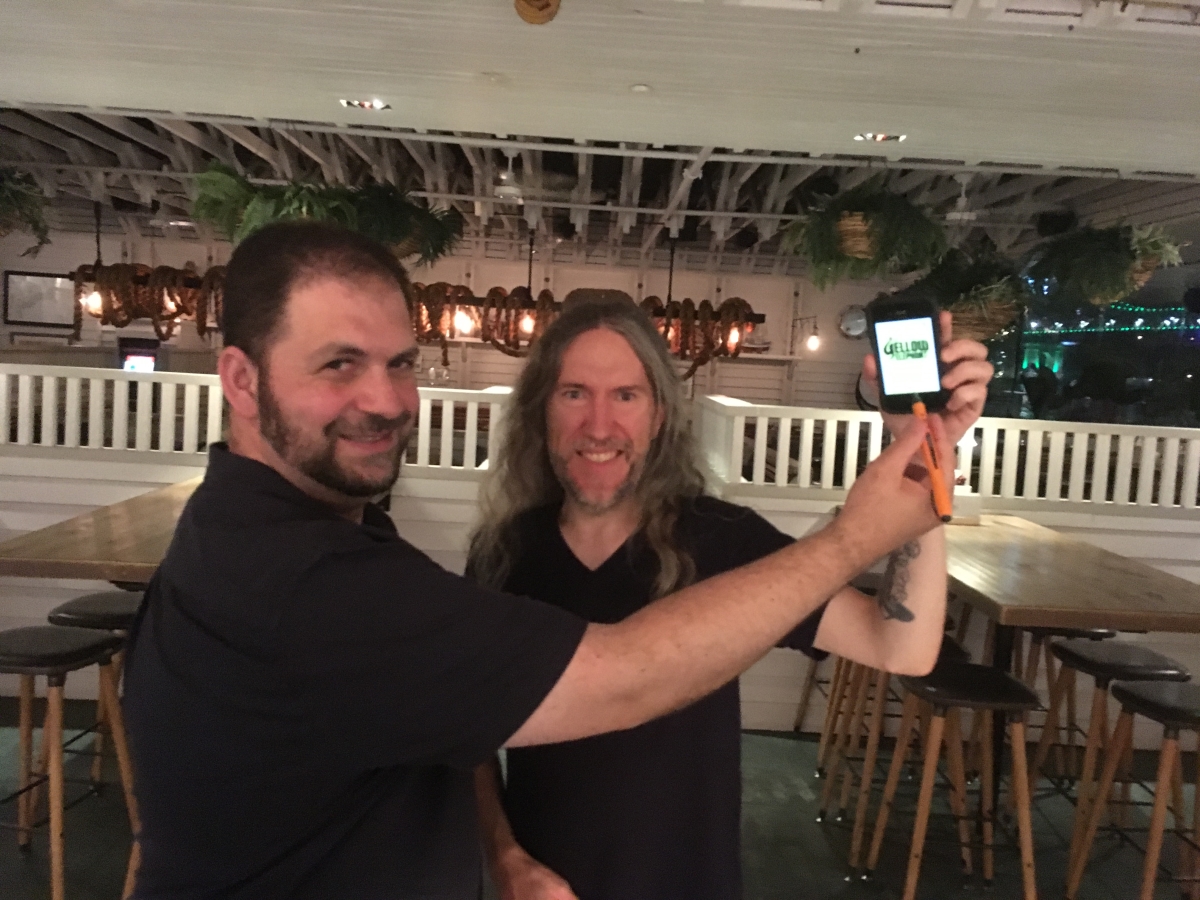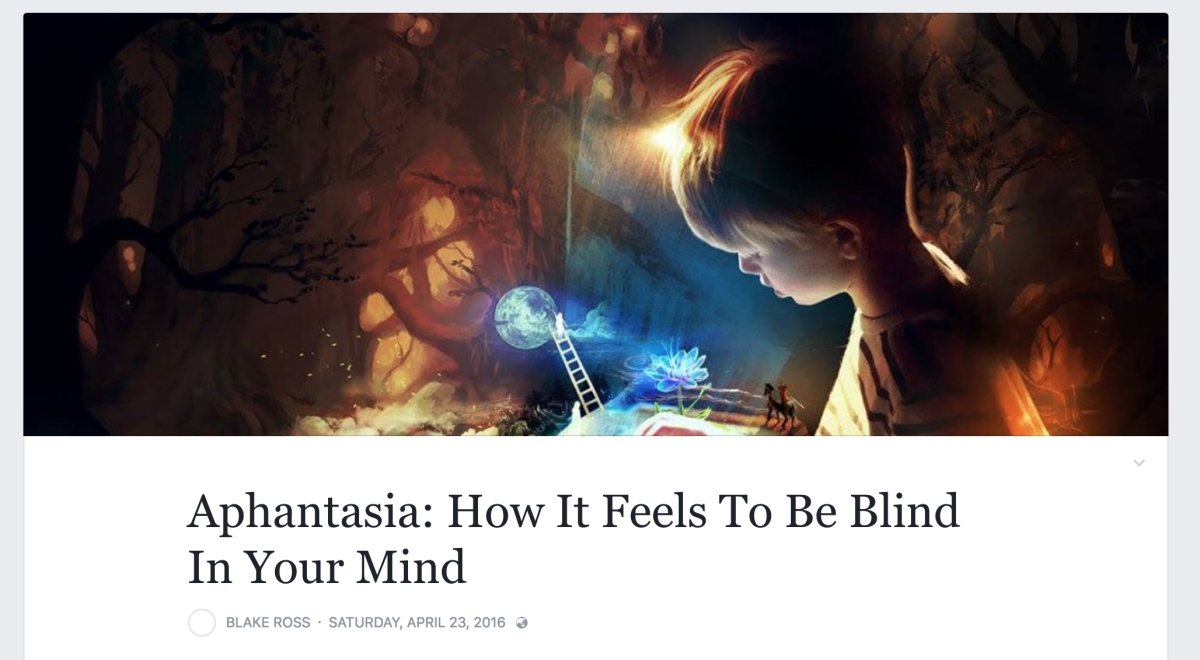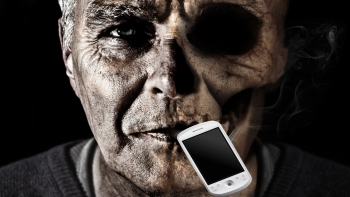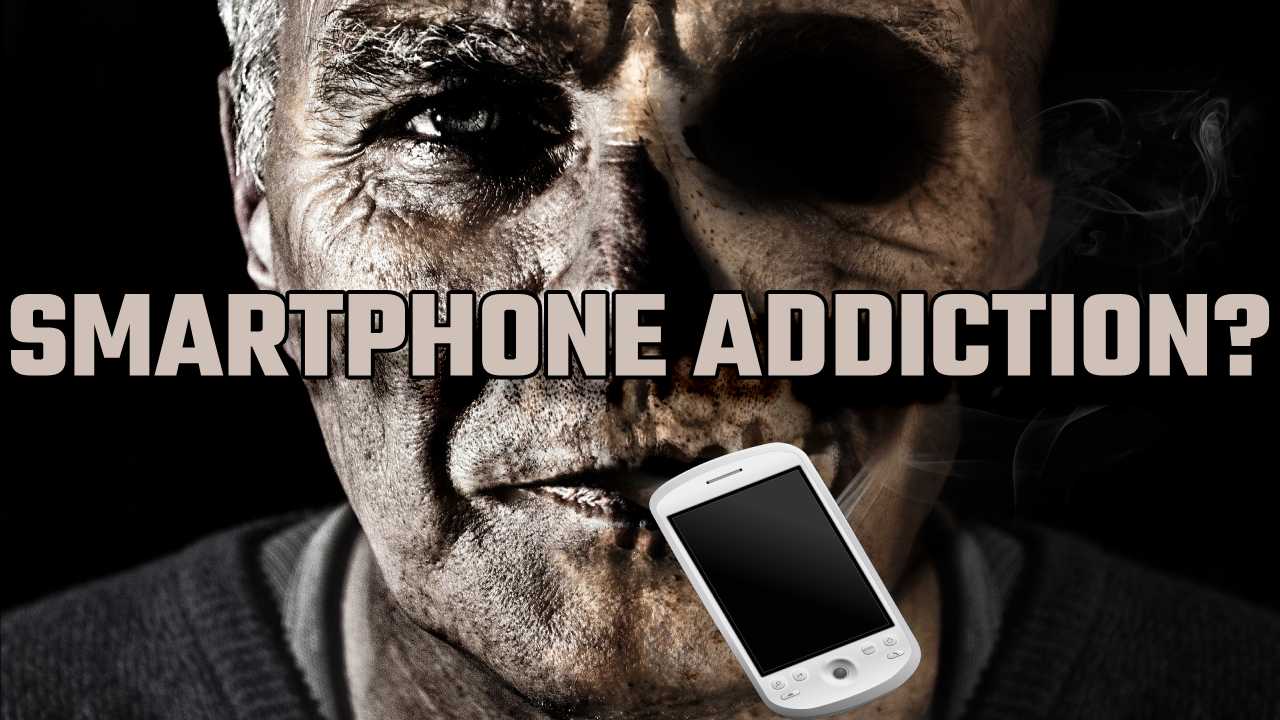Wed, 21 March 2018
Sounds like a magic word a magician would say before conjuring a rabbit from his hat, doesn’t it? But let me ask you this as you click play and listen to the audio version of this page: [smart_track_player url=”http://traffic.libsyn.com/magneticmemorymethod/Aphantasia__Develop_Your_Memory_Even_If_You_Cannot_See_Mental_Images.mp3″ title=”Aphantasia: Develop Your Memory Even If You Cannot See Mental Images” social_linkedin=”true” ] Can you visualize the magician pulling out the rabbit by his ears? For most of us, it will be easy to recall images inside our head, using our mind’s eye. However, if you could NOT see any image in your mind’s eye – no colors, no sounds, no smells, no textures, no flavors, nothing at all – you may have a condition called aphantasia or a blind mental eye. Don’t freak out, though. Many people have aphantasia, even magicians. Familiar with Penn Jillette (of Penn and Teller fame)?
He is a famous magician and entertainer, and he is an aphantasic(!). By his own admission, Penn says he cannot conjure a mental image of a person or a place to save his life.
What Exactly is Aphantasia? A Detailed DefinitionThe term ‘aphantasia’ comes from the Greek words a, meaning “without”, and phantasia, meaning “a capacity to form mental images”. The phenomenon was first described by the controversial psychologist Francis Galton – one of the pioneers of eugenics – in 1880.
The interest in the phenomenon was renewed after the publication of a study conducted by a team led by Dr. Adam Zeman, a professor of cognitive and behavioral neurology, at the University of Exeter.
Zeman’s team published a paper in 2015 on what they termed “congenital aphantasia”, now known simply as aphantasia. For Firefox co-creator Blake Ross it was a surprise revelation that other people could visualize things in the mind’s eye while he couldn’t. “I can’t ‘see’ my father’s face or a bouncing blue ball, my childhood bedroom or the run I went on ten minutes ago,” he wrote in a Facebook post.
According to Craig Venter, the biologist who created the first synthetic organism: “It’s like having a computer store the information, but you don’t have a screen attached to the computer.”
Is Aphantasia a Common Phenomena?
While research on the subject is still in its nascent stages, neurologists believe approximately one in 50 people or 2-5% of the population are non-visual-imagers. Sounds like a big number? Don’t be surprised. Being an aphantasic is nearly as common as having a food allergy. Neuroimaging has shown that mental imagery, although strongly associated with the left temporal lobe, requires the use of large networks of brain pathways. This means that aphantasia could potentially occur in different ways in different individuals.
The Two Likely Causes Of Aphantasia
However, the exact cause of aphantasia is still unknown. According to Dr. Zeman heredity and environment both are likely to be relevant causes. Interestingly, an aphantasic may have a visual memory which means they may be able to describe in detail about how things looked – the cat had blue eyes, the umbrella was pink and matched the skirt – even though they cannot see these very images in their mind’s eye. Moreover, many people who cannot visualize in mental images can think in sounds, while others can remember physical sensations. Penn says, when he dreams, he’s not sure if he sees images but has the sensation of knowing that “ideas wash over me”.
Want to Take The Aphantasia Test?
It is not possible to “see” what someone else is picturing inside their head unless they describe it to you. So how do we check what your mind’s eye is seeing? You can answer the Vividness of Visual Imagery Questionnaire, which is what psychologists use to rate different mental images of an individual, to test the strength of his mind’s eye. Although you don’t get any results, you’re helping a good cause by completing the survey and the questions themselves will tell you a lot about your imaginary visual style. [smart_podcast_player social_twitter=”true” social_facebook=”true” social_gplus=”true” social_linkedin=”true” social_email=”true” ]
How Aphantasia Affects Memory
Our brain stores information in two different ways – verbally and visually. Both these types of storage are independent of one another, and each can be used alone. Therefore, even people with aphantasia can complete the “tests of visual imagery” without too much difficulty. Here’s a quick test: Count the number of windows in your house. Quick #memory improvement exercise: Mentally count all the windows in your home.Click To TweetEven if you can’t see a “mental” image of your house and locate each window in that image, you would have an awareness of being there and recall from factual information the number of windows in your house. While aphantasics can remember things from their past, they experience these memories in a different way than someone with strong imagery. They often describe memories as a conceptual list of things that occurred rather than a video playing in their mind. As Ross says, he can ruminate on the “concept” of a beach, but cannot flash to beaches he has visited. “I know there’s sand. I know there’s water. I know there’s a sun, maybe a lifeguard. I know facts about beaches. I know a beach when I see it, and I can do verbal gymnastics with the word itself…But I have no visual, audio, emotional or otherwise sensory experience.” The brain has many unique ways of storing visual information than just as a picture.
Multiple Ways To Create Visual Imagery In Your Mind
Neuroscientists believe that the brain constructs visual imagery in more than one way. There are separate circuits for things like shape, size, color and spatial relationships, and when these are accessed together, we form an image of a memory. They think that aphantasics piggyback on neurons involved in controlling physical movements rather than using the visual brain circuitry to “visualize” or recall information. For instance, you can trace the letter B of the alphabet in your brain to know it has curves or you can use your mind’s eye to see its image.
Are There Any Aphantasia Benefits?
While the research is still out on this one, Penn says that because he thinks verbally and not visually, when he gets an idea, he can describe it instantly. While aphantasics’ use of spatial memory is stronger in the absence of visual memory. It gets better! People with aphantasia have been seen to perform on par with people who can visualize images in many tasks involving visual information. Moreover, a 2003 study stated the benefit of mental imagery is surprisingly small when it came to creative thinking. Does Aphantasia Hamper The Memory Techniques |
Wed, 14 March 2018
Not literally, but that twitchy connection to your phone? It definitely affects your abilities to concentrate and think deeply. And that means device addiction harms your ability to remember. Worse: Smartphone addiction not only turns you into a social pariah…
It Can Also Be Fatal!
In 2015, distracted driving (due to texting or talking on the cellphone) killed 3,477 people and injured another 391,000. And there’s more bad news… According to the National Safety Council, using cell phones while driving can make you more accident prone than even drunk driving… No wonder people are concerned over how cell phones are affecting their lives! In January this year, two of Apple’s biggest shareholders wrote an open letter to the company requesting it to provide “more choices and tools” so that parents could restrict their children’s smartphone usage time. The letter added that researchers have found this shocking statistic: “U.S. teenagers who spend 3 hours a day or more on electronic devices are 35 percent more likely, and those who spend 5 hours or more are 71 percent more likely, to have a risk factor for suicide than those who spend less than 1 hour.” Smartphone addiction is a serious issue and may need some creative problem solving using the C.R.E.A.T.E. formula: But here’s the real question: What about YOU? Are you displaying cell phone addiction symptoms? Let’s find out:
Are You A Nomophobic?
I know you will never admit it, but when you are unable to find your phone for even 30 seconds, it causes a minor anxiety attack. How do I know this? Because it happens to people every single second of the day. Look at this poor fellow: So, is he a nomophobic? Absolutely! Nomophobia or ‘NO MObile PHOne phoBIA’ is the fear of not being able to use your cell phone or have access to your device. Want to know if you’re truly addicted? Take this online quiz to find out. Nomophobia is real, but the medical community is not ready to declare overuse of cell phones as a clinical addiction.
Ignoring The Data?
They neglect to do so in the face of some shocking data. As the Joker suggests (I misquote), “whatever doesn’t kill us, only makes us stranger”…
Nearly one in ten people admitted to using their smartphones during sex, in the shower, on a movie date, in church or other place of worship, as per the 2013 Mobile Consumer Habits. What’s more, nearly three-quarters of the respondents said that they were always within five feet of their smartphones. Although doctors do agree that if you can’t stop using your phone, even when it’s harming your life, you may be “addicted.”
“Only a small percentage of people qualify as addicted. But many people overuse their smartphones.” This quote comes from Dr. David Greenfield, assistant clinical professor of psychiatry at the University of Connecticut and founder of the Center for Internet and Technology Addiction. Smartphone addiction is not listed as an official mental disorder listed in the Diagnostic and Statistical Manual of Mental Disorders. However, psychologists are debating about whether that should change. Some researchers also say that the development of smartphone addiction is similar to that of a gambling disorder (or gambling addiction), which is included in the Diagnostic and Statistical Manual of Mental Disorders. How does addiction work?
With gambling, the reward of winning once in a while is what hooks people to the habit. Smartphone addiction works on a similar principle. Most of the time, a phone notification will be insignificant. However, every once in a while…
Something Meaningful Happens!
Like a phone call from an old friend, or a Facebook notification that someone has tagged you in a photo. Researchers say this type of messages are irresistible and can lead to overuse or addiction to your device. There’s more… Device addiction can extend far beyond just the smartphone. Recently, the World Health Organization announced that video game addiction will now be classified as an official mental health condition in the 11th revision of the International Classification of Diseases. According to the WHO, gaming disorder is “characterized by a pattern of persistent or recurrent gaming behavior manifested by: 1) impaired control over gaming (e.g., onset, frequency, intensity, duration, termination, context); 2) increasing priority given to gaming to the extent that gaming takes precedence over other life interests and daily activities; and 3) continuation or escalation of gaming despite the occurrence of negative consequences.” “The behavior pattern is of sufficient severity to result in significant impairment in personal, family, social, educational, occupational or other important areas of functioning,” WHO adds. Whether it is to play video games or check your Facebook notifications, here’s the truth: Spending too much time with your smartphone will slowly but surely harm your mind.
How Smartphone Addiction Damages Your Memory
For starters, the presence of smartphone alerts is disrupting our already weak ability to focus on the task at hand. Moreover, excessive use of cell phones also causes headaches, impaired concentration and memory, and fatigue. If you are constantly using your mobile phone to surf the internet it affects the brain’s frontal lobe and brainstem functions, resulting in decreased ability to speak, reason and comprehend social cues. Researchers also found that smartphone addiction can lead to an imbalance in brain chemistry that triggers depression and anxiety.
Ultimately, smartphone addiction can impair your ability to interact in the real world to the detriment of your personal and professional relationships.
It’s Not Just Brain Damage
Smartphone addiction does more than alter your brain chemicals. Your posture also gets affected when you use your phone all the time. And according to the National Center for Biotechnology Information, posture affects mood, behavior and memory. Therefore, frequent slouching to look at your device screen can make you depressed. What’s more, Researchers at the University of Michigan state that the tucking your chin (or chins) and hanging your head to look at the smartphone is also causing empathy levels to fall and narcissism to rise among individuals.
A Reliable, Easy & Fun Way To Learn Things |
Thu, 8 March 2018
Turns out there’s a solid reason why. A few reasons, actually. And in this episode of the Magnetic Memory Method Podcast, I speak with 4x Australian Memory Champion Tansel Ali talks about memory improvement and positive thinking. This may well be the most valuable hour you spend listening to a podcast about memory improvement. Why? For starters… In addition to discussing the role of gratitude in coming up with effective visualizations when using mnemonics, Tansel discusses the importance of reading, memorizing cards with music on and focusing on the right things to maximize performance in your memory and life. Plus, when you scroll up and click play above, you’ll soon discover… * Why Tansel was originally skeptical about memory improvement and thought all TV memory trainers were fake. * The factors responsible for making people suspicious of memory techniques because they seem like magic “tricks.” * How Tansel wound up at his first memory competition and took second place. * The other rewards memory improvement brings you, including mindset, job performance and fun. * Tansel’s transition from memory competition to enhancing his own life and the lives of others through teaching memory. * Why you need to continue challenging your memory almost like the physical training of the body to keep the mind in top shape. * Exactly how participating in memory competitions help you develop preparation and developing positive self-talk. * Why Tansel sometimes FORCES himself NOT to use memory techniques in order to challenge his brain. * Tansel’s definition of consistency and the development of successful habits that you can use to challenge yourself. * Why you should go without fear of making mistakes for the health of your brain and the development of effective discipline.  Tansel Ali book signing of The Yellow Elephant on Kindle for me in person. * Tansel’s personal training regime and how he makes it count. * How Tansel thinks about visualization as a kind of muscle and how he trains it for competition. * A quick comparison of Alex Mullen’s training regime and Tansel’s focus on efficiency to improve the right skills and maximize performance. * A discussion of aphantasia and why you don’t actually have to see pictures in your mind to use memory techniques. * How Tansel uses feelings and thinking in words to create mnemonic imagery – and why feeling creates more impact. * How to give the mnemonic imagery you create greater value through personalization. * Practical reasons you should memorize cards. For one thing, they set you up to make creative decisions that goes beyond just remembering information. And here are 13 more reasons you should have a system for remembering cards. * Tansel’s thoughts on music and memory and how he memorizes cards with music playing. * The benefits of training your memory and where to start (also discussed in this video): * The importance of making memory training fun and interesting, rather than a chore. * Tansel’s history with apps for memory training and meditation and how to reduce stress. * How Tansel changed from wallowing in negativity to living in positivity. * Why you don’t have to use bizarre or violent imagery to remember information and positive options you can explore for creating and using mnemonics. * Why we both approach shows like Breaking Bad with caution in order to maintain a positive mindset. Not that Breaking Bad can’t be useful for memory improvement, as you can see here: * The role of gratitude in increasing the value of your imagination by focusing on specifics. * Why “the law of attraction” is useless without taking action – and how you can use mindset to create the excitement needed to make sure you achieve your goals. * Why Tansel wishes he had read more as a young person. * Some of Tansel’s favorite memory books and why they changed his life, including books by Tony Buzan and Dominic O’Brien. * Tansel’s take on Digital Amnesia and why he chooses to see the positive side of the debate about the so-called Google Effect. * How Turkish is helping Tansel learn Japanese even without using Kevin Richardson’s Learn Japanese App (a.k.a. Memory Palace). I want to thank Tansel for being on the show and thank you for listening. Please be sure to grab his books, visit his site and get connected on his various online platforms using the links below. Further Resources Yellow Elephant: Improve Your Memory And Learn More, Faster, Better by Tansel Ali How to Learn Almost Anything in 48 Hours: Shortcuts And Brain Hacks For Learning New Skills Fast by Tansel Ali Subscribe to Tansel Ali’s YouTube channel The post Tansel Ali On How Gratitude Can Help You Remember Almost Anything appeared first on Magnetic Memory Method - How to Memorize With A Memory Palace.
Direct download: Tansel_Ali_On_Gratitudes_Actionable_Role_In_How_To_Learn_Almost_Anything.mp3
Category:Podcast -- posted at: 7:31am EDT |
The Magnetic Memory Method Podcast

Categories
generalMemory Improvement Tools
Memory Method Tips
Brain Exercises for Memory Improvement
Memory Improvement Case Studies
Podcast
Guest Post
Memory Palace Tactics
Practical Memory Techniques
Uncategorized
Improve Memory Q&A
Archives
AprilMarch
February
January
December
November
October
September
August
July
June
May
April
March
February
January
December
November
October
September
August
July
June
May
April
March
February
January
December
November
October
September
August
July
June
May
April
March
February
January
December
November
October
September
August
July
June
May
April
March
February
January
December
November
October
September
August
June
May
April
March
February
January
December
November
October
September
August
July
June
May
April
March
February
January
December
November
October
September
August
July
June
May
April
March
February
January
December
November
October
September
August
July
June
May
April
March
February
January
December
November
October
September
August
July
June
May
April
March
February
January
December
November
October
September
August
July
June
May
April
March
February
January
December
November
September
| S | M | T | W | T | F | S |
|---|---|---|---|---|---|---|
| 1 | 2 | 3 | ||||
| 4 | 5 | 6 | 7 | 8 | 9 | 10 |
| 11 | 12 | 13 | 14 | 15 | 16 | 17 |
| 18 | 19 | 20 | 21 | 22 | 23 | 24 |
| 25 | 26 | 27 | 28 | 29 | 30 | 31 |
Syndication

 Aphantasia.
Aphantasia.





 Can smartphone addiction fry your brain cells?
Can smartphone addiction fry your brain cells?




 Tansel Ali is possibly the most positive memory champion on the planet.
Tansel Ali is possibly the most positive memory champion on the planet.